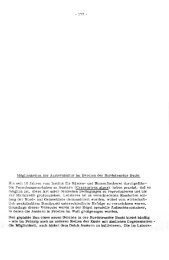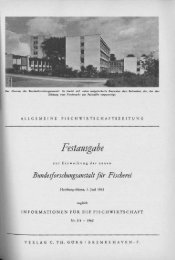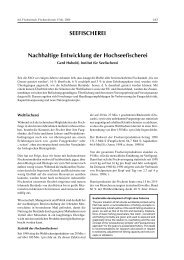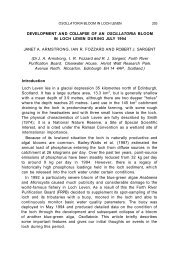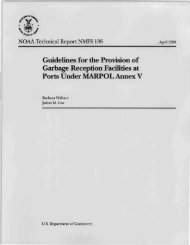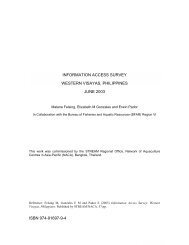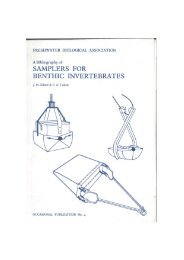The Economic Importance Of Marine Angler Expenditures In
The Economic Importance Of Marine Angler Expenditures In
The Economic Importance Of Marine Angler Expenditures In
You also want an ePaper? Increase the reach of your titles
YUMPU automatically turns print PDFs into web optimized ePapers that Google loves.
and $64.9 million in sales from households purchasing<br />
goods and services (induced impacts). Non-resident<br />
expenditures resulted in an additional $41.5 million in<br />
direct sales for Massachusetts businesses, $9.8 million in<br />
indirect sales, and $14.1 million in induced sales. <strong>The</strong><br />
personal income generated from recreational fishing<br />
expenditures by residents was also considerably higher<br />
than for non-residents. Resident expenditures generated<br />
a total of $131.1 million in personal income to<br />
the state of Massachusetts, while non-resident anglers<br />
generated about $28.5 million in personal income. <strong>In</strong><br />
terms of employment, approximately 4,412 jobs were<br />
dependent upon resident expenditures and 1,030 jobs<br />
on non-resident expenditures in Massachusetts.<br />
Overall, the highest sales, income, and employment<br />
impacts were generated by angler expenditures in New<br />
Jersey (Table 38). <strong>The</strong> $482.4 million spent on retail<br />
goods and services by anglers in New Jersey generated<br />
$469.1 million in instate sales, $190.2 million in income,<br />
and supported 6,200 jobs in New Jersey.<br />
A substantial portion of the items purchased by anglers,<br />
however, was imported into each state. As a result,<br />
many of the angler dollars spent in each coastal state impacted<br />
the economies of other states and countries. <strong>The</strong><br />
amount lost to other regions can be calculated from the<br />
difference between the total impact expenditures and<br />
the direct sales impacts in the first and second table for<br />
each state. For instance, of the $486.7 million spent by<br />
resident and non-resident anglers on retail goods and<br />
services in Massachusetts, only $233.3 million (48%)<br />
directly affected the Massachusetts economy (Table 26);<br />
$253.4 million in goods and services were imported<br />
into the state in response to angler demands. Thus, on<br />
average, only about 48 cents of every dollar spent in<br />
Massachusetts by recreational fishermen remained in<br />
the state in 1998. Across all coastal states, this amount<br />
ranged from a low of 44 cents in Rhode Island to a high<br />
of 64 cents in New Jersey.<br />
<strong>Expenditures</strong> for rods and reels was the single most<br />
important expense category in generating sales, income,<br />
and employment in each state, except in New<br />
Hampshire and Delaware. <strong>In</strong> New Jersey, for example,<br />
rod and reel expenditures generated over $71.3 million<br />
in sales, $33.2 million in income, and approximately 988<br />
jobs (Tables 39–41). Purchases of new fishing vehicles<br />
and boat expenses (i.e., mooring, storage, maintenance,<br />
and insurance) generated the highest sales impacts in<br />
Delaware ($14.0 million) and New Hampshire ($8.1<br />
million), respectively (Tables 9 and 33). Lodging fees<br />
also contributed significant sales, income, and employment<br />
impacts to all of the states, as did boat fuel<br />
purchases, private transportation expenses, and sales<br />
of tackle and gear.<br />
<strong>The</strong> impacts created by anglers fishing from private<br />
boats and from the shore were higher than those pro-<br />
duced by party/charter boat fishing in all of the coastal<br />
states. <strong>The</strong> sales, income, and employment impacts created<br />
by party/charter boat fishing and private/rental<br />
boat fishing were the highest in New Jersey (Table 42),<br />
while the impacts generated from shore fishing were the<br />
highest in Massachusetts (Table 30). Overall, angler trip<br />
expenditures in New Jersey generated more sales, income,<br />
and employment impacts than any other coastal<br />
state (Table 42).<br />
Federal taxes generated by angler purchases ranged<br />
from $4.5 million in New Hampshire (Table 37) to $55.0<br />
million in New Jersey (Table 43). Revenue received by<br />
state/local governments varied from $3.1 million in<br />
New Hampshire (Table 37) to a high of $39.5 million in<br />
Massachusetts (Table 31). <strong>In</strong> total, angler expenditures<br />
in New Jersey generated the highest tax revenues of all<br />
the coastal states ($93.2 million).<br />
Southeast Region results<br />
Overall, the highest sales, income, and employment<br />
impacts were generated by angler expenditures in<br />
Florida (Table 80). <strong>The</strong> $4.9 billion spent on retail<br />
goods and services by anglers in Florida in 1999 7 generated<br />
$4.5 billion in instate sales, $1.9 billion in income,<br />
and supported 63,975 jobs in Florida. Florida was followed<br />
by North Carolina and Louisiana, respectively,<br />
in generating sales, income, and employment impacts<br />
(Tables 104 and 92). Boat maintenance/expenses was<br />
the single most important category in generating sales<br />
in each state, except in Georgia and North Carolina,<br />
where lodging expenditures produced the highest sales<br />
impacts. Lodging expenditures also supported the most<br />
employment in all states, except Louisiana, Mississippi,<br />
and South Carolina where purchases of rods and reels<br />
was the most important employment category. <strong>The</strong> impacts<br />
generated by anglers fishing from private boats<br />
and from the shore were higher than those produced by<br />
party/charter boat fishing in all of the coastal states.<br />
Resident impacts were higher than those of non-residents<br />
in all of the coastal states. <strong>In</strong> South Carolina for<br />
example (Table 110), the $297.9 million in retail purchases<br />
by resident anglers in 1999 generated a total of<br />
$248.7 million in sales as follows: $166.2 million in sales<br />
for the direct sectors in South Carolina ($49.2 million<br />
was transferred to out-of-state producers of goods and<br />
7 Total expenditures by resident anglers in Florida in 1999 approached<br />
$8.4 billion in Gentner, Price, and Steinback (2001a).<br />
However, that estimate of expenditures did not distinguish between<br />
purchases made at the retail level and those made through<br />
household-to-household sales. Household-to-household sales of<br />
merchandise are considered transfer payments from one household<br />
to another and generate no economic impacts. <strong>The</strong>refore, in<br />
this paper, we removed those household-to-household sales associated<br />
with used boats and vehicles prior to generating economic<br />
impacts.<br />
5





